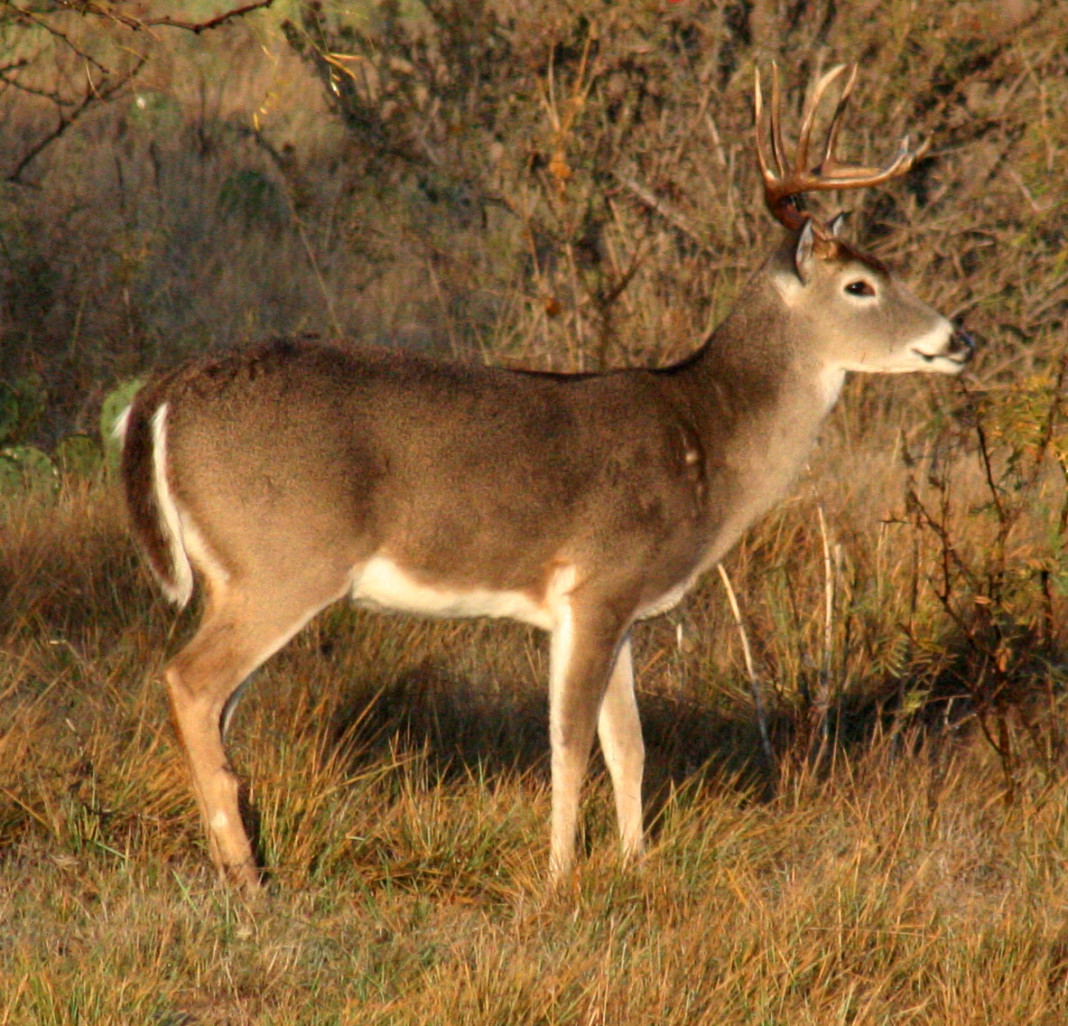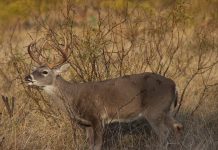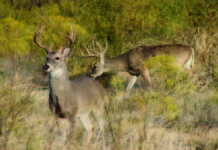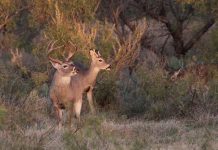This deer season may not be one for the overall record books, but in Texas that type of prognostication isn’t dire. In fact, even in what biologists and land managers would term an “average” or even “below average” season, we’ve still got some great hunting opportunities.
The Lone Star State still has the largest whitetail population in the country and a generous overall framework in which to hunt them. However, lingering drought heading into this fall’s season didn’t lay the groundwork for as optimistic an outlook as in past years when optimum or even average moisture levels set the stage for spectacular predictions from those in the know about whitetail predictions.
What this fall’s forecasts may lack in sheer numbers or antler size is more than made up for in the pure dimensions of our white-tailed deer range, which extends all the way from the Oklahoma border at the northern peak to the Rio Grande in deep South Texas, and from the eastern border with Louisiana all the way into the eastern edge of the Trans-Pecos.
Simply put, we have millions of deer and millions of acres to hunt them on.
The state also allows us liberal limits on our hunting licenses, which means every fall season is a great opportunity to take animals off the range while filling your freezer with some tasty fare. This season especially is one in which hunters should use as many of the tags that accompany a hunting license as they can, according to biologists across the state.
With that in mind, here’s a glimpse into what to expect heading into this year’s seasons.
Alan Cain, white-tailed deer program leader with the Texas Parks and Wildlife Department, said this season – like most other years – again will be shaped by Mother Nature.
Cain said that regardless of what part of the state you’re hunting, the odds are good that you’ve got plenty of deer. And he would know – he’s got piles of detailed data dating back decades and gathered in various forms by biologists. Cain also spends time throughout the year discussing all things whitetail with biologists, land managers, hunting associations and even the everyman hunter himself.
He said production from this past season should bode well, including having a good fawn crop across much of the state and a good carryover of young bucks and does into this fall.
Cain also noted that the regular hot spots should remain that way this season.
“Well, it appears that 2014 will be similar to the last three years with regards to the deer hunting forecast, much of that related to the drier conditions Texas continues to experience,” he said. “Parts of North Texas and areas east of Interstate 35 received some reasonable rains this spring, giving the habitat and vegetation a much-needed boost to stay green (as we head into summer). This should translate into good conditions for deer in these areas of the state.
“However, South Texas, the Hill Country, Panhandle and the western region of the state were not so lucky in the annual rainfall lottery. As a result, forbs which are preferred by deer and are important from a deer forage and nutrition aspect were in limited supply. Consequently, deer didn’t get the extra nutritional boost to help in the body weight and antler growth department.”
As usual, it doesn’t take much to recognize the need for moisture, Cain said.
“The reason biologists look at rainfall as a predictor of hunting season is the direct correlation between rainfall, habitat (nutrition and cover deer need), and antler quality and fawn production all of which impact what hunters see each fall,” he said. “Although difficult to predict mesquite bean and prickly fruit crops seems to be more prevalent during dry years and this summer looks to be a good year for these mast crops that provide a good forage resource to help deer meet the demands of raising fawns and growing antlers during the stressful part of the summer. If those mast crops last into the fall early hunting season will be a bit challenging as deer may not visit the corn feeder as frequently. It’s a bit early to predict acorn production this year so hunters will have to take the wait-and-see approach as to how that may play out.”
Cain said annual deer surveys are conducted each year, but it’s typically reasonable to look back at the previous year’s population to get an indication of what the new hunting season may bring in regards to number of deer on the range.
“Statewide population estimates for 2013 were 3.8 million white-tailed deer,” Cain said. “Those statistics work out to about 39 deer per 1,000 acres on average. Hunters should keep in mind density estimates vary dramatically depending on the region of the state your favorite hunting spot is located and probably more importantly the quality and quantity of native habitat that is attractive to white-tailed deer.”
When it comes to hot spots for whitetails, Cain pointed to distinct areas of the state, which should come as no surprise to hunters.
“The Hill Country supports the highest deer population in the state with an estimated 2.1 million deer, or an estimated deer density of 113 deer per 1,000 acres,” he said. “The Post Oak Savannah and Cross Timbers regions support about 400,000 deer in each region, or 35 and 37 deer per 1,000 acres, respectively. South Texas has a much lower estimated deer population around 230,000 deer in the region, but hunter densities are much lower in this region compared to the Post Oak Savannah and the Pineywoods.
“East Texas deer population estimates for 2013 were about 240,000, or 18 deer per 1,000 acres. On the western edge of the whitetail range in the southern High Plains, deer populations are much lower with estimates of about 11,000 deer. The Trans-Pecos region has a smaller white-tailed deer population, estimated at 50,000 animals, compared to the rest of the state, but densities can be quite high in the area exceeding 30 deer per 1,000 acres and in better habitat 66 deer per 1,000 acres.”
The outlook may not be as high as in previous years, but that doesn’t mean deer won’t be readily available to hunters, Cain said.
“Deer population trends in most regions of the state are stable or in some cases increasing at a slow rate,” he said. “Bottom line from a hunter perspective is there will be plenty of animals to pursue in 2014. If you want to increase your odds of harvesting a deer in 2014 I’d be looking to hunt the Hill Country which supports the highest deer population in the state. With that target-rich environment, hunters should be able to put some venison in the freezer this year.”
Cain again touted the liberal annual bag limit for the average hunter, noting that it again is a good year to use a full complement of your tags.
“I would encourage hunters to continue to fill their tags and reduce deer populations especially in the drier areas of the state such as the Hill Country where deer numbers are likely beyond what the habitat should be supporting, especially under these conditions,” Cain said. “If hunters and landowners are unsure about how many deer they should harvest on their lease or ranch, consider contacting the local TPWD wildlife biologist (www.tpwd.texas.gov/landwater/land/technical_guidance/biologists) to discuss possible deer survey options and deer harvest recommendations. Establishing a population estimate on the hunting property can help hunters better manage the deer herd in their localized area and meet deer or hunting management goals.”
Kevin Mote, TPWD’s Cross Timbers district leader, said the overall deer hunting objective is to provide maximum quality hunting opportunity while conserving the resource. He said last fall and winter again brought solid hunting across some of the best habitat in the state.
“As with every year, we would like to have taken more does,” Mote said. “Although the population density has remained fairly stable since 2008, removing a slightly higher percentage would help put a little better habitat in the bank for years like 2011. Some individual ranches we work with do that.”
Mote said that it’s not uncommon for areas of Central Texas to have similar deer densities as those in other hot spots including some portions of the Hill Country, which again bodes well for hunters.
“Sex ratios and remained consistent at around three does per buck while the fawn crop ranged fairly normal across the area,” he said, noting that habitat management continues to improve, something that should come as no surprise to hunters. “The quality of hunting opportunity anywhere in the state is directly proportional to the quality of habitat management done on that particular property and that varies greatly across the area.”
While notable areas of the state, including the Hill Country and the Pineywoods, receive much more hunting pressure, other locales are worth a hard look, especially if you’re seeking a new lease. Among the least-hunted but prime areas that can feature surprisingly high deer populations are the eastern Panhandle, the southern Rolling Plains and the eastern edge of the Trans-Pecos.
Philip Dickerson, TPWD’s Trans-Pecos district leader, said the region, while a mule deer hotbed, isn’t conducive to great whitetail hunting compared with other more heavily hunted spots. However, there are opportunities to fill your whitetail tags.
“The Trans-Pecos has been in a slow recovery mode ever since 2011,” he said. “We have not had average rainfall since but we seem to be holding our own with regard to numbers and quality of deer. Many landowners have been conservative with harvest, not knowing when the drought would break. I’m looking for much the same this year.”
One tool that also has been implemented and embraced across the state is the Managed Lands Deer Permit program, which allows landowners more liberal frameworks for harvesting deer in exchange for allowing TPWD personnel to help manage and to keep records on private tracts in an attempt to better manage the overall population. MLDP program participants get more tags and were able to harvest bucks and does from October through the end of February this past season.
There are three levels of MLDPs (1, 2 and 3) and higher levels offer additional harvest flexibility to the landowner but also have stricter requirements. There is no fee or written application other than a Wildlife Management Plan approved by a TPWD biologist or technician.
The state also offers a variety of inexpensive opportunities in state parks, wildlife management areas and even private ranches each year, with thousands of permits issued annually. There also are numerous drawings for youth hunts, which not only can be a great way to introduce children to the pastime, but also to add to your potential meat haul. There are a number of hunts that typically have high numbers of applicants each year, but for as little as $3 you too can put your name in the hat for drawings for what can turn out to be great hunts.
And should you be lucky of enough to gain entry to these areas, the old saying of venison being the most expensive meat per pound certainly doesn’t hold true considering the frugal nature of the program.
One way for some hunters who may not have access to leases or family tracts of land is to buy a public hunting permit, which costs $48, and take advantage of hundreds of thousands of acres that are available. That permit can be used to gain access to a variety of resources on almost 900,000 acres.
This season has shaped up to be superb regardless of what whitetail country you’re hunting. There are opportunities galore when it comes to filling your tags. Texas long has had the greatest whitetail hunting in the country, not just for the folks who can afford to spend the big bucks in their attempts to harvest the big bucks, but also for the average hunter who still enjoys hunting as much as possible but may not necessarily get to head afield as much as they’d like.
This should be a perfect year to get back to the basics of deer hunting – mainly the opportunity to spend time outdoors during a splendid time of year while providing for your family should you enjoy success.






















